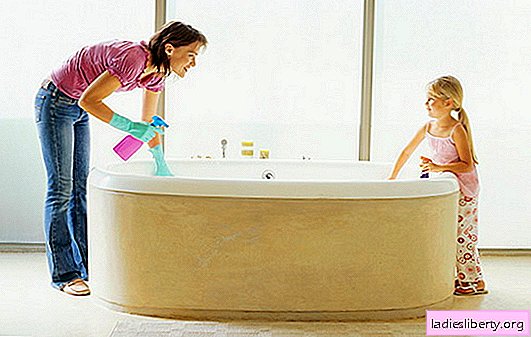
Many of us are familiar with the sense of admiration that you can experience by looking at the smooth and snow-white surface of a new bathtub or a newly laid, sparkling and even tile in the bathroom.
However, even with regular maintenance, these surfaces fade over time and can become covered with a thin layer of limescale and rust.
This is due to the huge amount of minerals and salts contained in tap water that are deeply absorbed into any, even the hardest surfaces.
It is not easy to deal with plaque at home, because timely care alone is not enough.
To get rid of the problem, you need to not only have in stock a set of different bath care products, but also be able to use them correctly.
How to clean the bath from plaque: chemistry and folk methods
The main reason for the appearance of plaque on the surface of the bath is the presence in the water from the tap of all kinds of impurities. For example, salts of magnesium and calcium, interacting with the remnants of detergents, are gradually deposited on the enamel of the bath and form a limescale. And various mechanical particles and microorganisms that accumulate in water pipes, getting on the surface of the bath, not only leave traces of contamination on it, but can also cause an unpleasant smell and even mold. In this regard, it is recommended that after each use of the bath, rinse it thoroughly and wipe it dry.
If pollution of the bath was not avoided, then all kinds of chemicals will help clean the bath from plaque. Many housewives believe that good bath cleaners are sold only in special stores and cost a lot of money. In fact, there are many folk methods that can achieve the desired result, using only ingredients that are widely used in everyday life and are available in every home.
Enamel bath cleaning
Cast iron and steel enameled bathtubs are very popular due to their strength and reliability. Such baths can last for more than a dozen years, however, the enamel that covers their surface, over time, begins to become covered with plaque and fades. Before cleaning a bathtub with a modern chemical agent, make sure that it is designed specifically for this type of bathtubs. An improperly selected product can not only not give the desired effect, but even damage the enamel. This is especially true for powder cleaners. In addition to abrasive substances, they may contain aggressive chemical compounds that can cause irreparable harm to enamel. To avoid this, carefully read the contents of the cleaning agent on the packaging.
If there isn’t a store tool at hand, then you can clean the bath of plaque using the proven folk method using ordinary baking soda and vinegar. To do this, you need to mix a few tablespoons of soda with a small amount of water until a porridge-like solution forms. With this solution, you need to rub a wet bath and wait 15-20 minutes. Then a small amount of vinegar is applied to the surface of the bath. It can be mixed in equal proportions with bleach - this will give the enamel an even more radiant snow-white shade. After half an hour, the surface of the bath must be washed off with a sponge or soft brush and rinsed with plenty of cold water.
Ammonia and hydrogen peroxide are good at traces of rust on enamel. To remove yellow plaque, it is necessary to mix 2 parts of ammonia and one part of hydrogen peroxide, and apply the resulting solution to a contaminated surface. After 15 minutes, rinse the surface with cold water. It is important to remember that vinegar and ammonia are aggressive chemicals and have a pungent unpleasant odor. Therefore, it is necessary to clean the bath only in protective rubber gloves, and upon completion, ventilate the room well.
Acrylic bathtub cleaning
Acrylic began to be used for the manufacture of bathtubs relatively recently. Due to the relative cheapness, variety of shapes and beautiful appearance, acrylic bathtubs have become increasingly popular. However, to maintain cleanliness and shine, these bathtubs need special care. First of all, it should be remembered that no cleaning powders can be used to clean acrylic. They leave small scratches and gray marks on its surface that cannot be removed later. And even liquid products and gels can be applied only if they are intended only for acrylic baths, since they do not contain any aggressive components (acetone, ammonia, etc.).
It cleans the surface of an acrylic bath well with ordinary table vinegar and citric acid. With their help, you can achieve deep cleansing even without the use of special tools from the store. To do this, you need to draw water at room temperature into the bathtub, pour half a liter of vinegar or pour a bag of citric acid, stir and wait 12 hours. After this time, you need to drain the water and rinse the bath. To prevent acrylic from corroding, acid can be neutralized with ordinary dishwashing liquid.
How to wash tiles in the bathroom from plaque: a review of tools
High humidity and the presence of harmful impurities in tap water lead to contamination of the walls and floor of the bathroom, which in most cases are tiled with ceramic or tile. Therefore, sooner or later you have to ask yourself the question: how to wash tiles in the bathroom from plaque? To remove small impurities and daily care, a soap solution or standard cleaning products sold in any store will be quite enough. And where they do not help, various aids checked by many housewives come to the rescue:
• Table vinegar. Acetic acid will help to cope not only with limescale, but also with difficult to remove impurities, as well as with fungus and mold. To do this, apply vinegar to the surface of the tile with a rag or spray and leave for several minutes, then rinse with plenty of cold water.
• Ammonia. For two liters of water, one tablespoon of alcohol is added. The resulting solution is applied to the tile using a spray gun and after a few minutes it is wiped with a clean damp cloth.
• Soda. To effectively remove limescale, soda is added to the liquid detergent and evenly applied to the surface of the tile.
• Window Cleaner. All kinds of sprays for washing glass surfaces due to the high alcohol content will also help to quickly and efficiently clean tiles in the bathroom from plaque.
• Steam cleaner. This household appliance, which appeared on the mass market relatively recently, is the safest tool for cleaning tiles, since it does not require the use of any chemical agents. In addition, steam under high pressure penetrates even narrow gaps and seams, removing fungus and mold.
How to clean the bath from plaque without damaging the enamel
Strong pollution and limescale on the surface of the enameled bath is not only a spoiled appearance, but also a headache for the hostess, because in the process of their removal enamel can be damaged. Therefore, it is important not only to know how to clean the bath from plaque, but also how to do it correctly.
Use only soft materials (fabrics or sponges) to clean the bath. Hard brushes and metal scrapers scratch the surface, which can lead to cracking.
Also, enamels can also be damaged by cleaning products containing sulfuric, nitric, or some other potent acid. They are usually used to remove limescale from toilets and metal surfaces; they are not suitable for washing a bath.
When using a cleaning powder, it will be useful to familiarize yourself with its composition, which must necessarily contain anti-corrosion inhibitors - special substances that protect the enamel surface from damage. There are no inhibitors in some cheap cleaning products, so it’s best to refrain from using them.
How to wash tiles in the bathroom from plaque and not spoil it
For many housewives, it is no longer a secret that it is much easier to regularly look after the tiles than to wash the tiles in the bathroom from plaque. After all, the process of cleaning lime scale is associated with the risk of damage to tiles or ceramics. To secure and simplify this complex procedure, a few practical tips will help:
1. Before cleaning, open the hot water tap and close the bathroom door for a while. The resulting steam will condense on the tile, moistening its surface - this will facilitate the removal of plaque.
2. Do not apply detergent immediately to the entire area of the tile. In some cases, washing off a dried cleaning agent is much more difficult than plaque.
3. Do not use hard brushes and fiberglass sponges: they scratch the glossy surface of the tile. To clean the joints between the tiles, you can take an old toothbrush.
4. Refrain from using liquid soap, since after it stains remain on the tile.
5. Restored enamel, unlike factory enamel, has a less durable structure, therefore, requires more gentle care. To clean the bath after restoration, it is better to use products designed for acrylic bathtubs.











